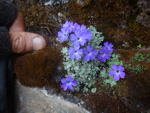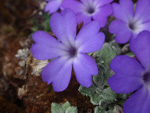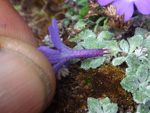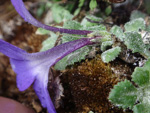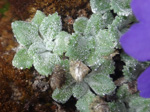Primula tenella King ex G.Watt
Section Minutissimae
Link to Flora of China description
Type specimen: King s.n., 1878 (Phari, E. Tibet) resides at CAL (specimens CAL0000017293, CAL0000017294) and K (specimens K000639442, K000639443) and E (specimen E00024523) and P (specimen P04907201).
Primula rebeccae Richards: Type specimen: G. & S. Miehe, #00-164-07 resides at E (specimens E00180782, E00180783, E00155404) and at BM (specimen BM000839349).
Epithet: Named for the slender, delicate stem.
Distribution: Bhutan, Tibet.
Primula tenella was first discovered in the Chumbi valley by King's collector, then later in nearby Bhutan by Cooper, Gould, and Ludlow & Sherriff. In 2004, Richards described P. rebeccae, comparing it to the much larger species P. caveana which also grows in the same region, but no comparison was made with P. tenella. The type location for P. rebeccae is Jangothang, Bhutan, less than 40kms away from Chumbi, and several collections of P. tenella have been made in this area. There is no difference between P. rebeccae and P. tenella from the evidence available. See blog post: "Primula rebeccae A.J. Richards a synonym for Primula tenella King".
Primula flagellaris was discovered in the Zemu Valley, Sikkim by Smith & Cave and then later in Bhutan by Ludlow & Sherriff. It has been previously lumped with P. tenella as a variation
as the differences are minor. The last image is of P. rebeccae given in the original description. If you have images of P. tenella from Chumbi, please contact the webmaster. 如果你有这个物种的图像,请与网站管理员联系。







